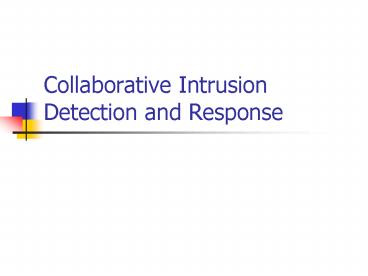Collaborative Intrusion Detection and Response - PowerPoint PPT Presentation
1 / 19
Title:
Collaborative Intrusion Detection and Response
Description:
Collaborative Intrusion Detection and Response Limitations of Monolithic ID Single point of failure Limited access to data sources Only one perspective on ... – PowerPoint PPT presentation
Number of Views:46
Avg rating:3.0/5.0
Title: Collaborative Intrusion Detection and Response
1
Collaborative Intrusion Detection and Response
2
Limitations of Monolithic ID
- Single point of failure
- Limited access to data sources
- Only one perspective on transactions
- Some attacks are inherently distributed
- Smurf
- DDoS
- Conclusion Complete solutions arent
3
Sharing Information
- Benefits
- Increased robustness
- More information for all components
- Broader perspective on attacks
- Capture distributed attacks
- Risks
- Eavesdroppers, compromised components
4
Sharing Information
- Communication risks can be resolved
cryptographically (at least in part) - Defining appropriate level of expression
- Efficiency
- Expressivity
- Specificity
5
CIDF
- Common Intrusion Detection Framework
- Collaborative work of DARPA-funded projects in
late 1990s - Task Define language, protocols to exchange
information about attacks and responses
6
CISL
- Common Intrusion Specification Language
- Conveys information about attacks using ordinary
English words - E.g., User joe obtains root access on
demon.example.com at 2003 Jun 12 1415 PDT
7
CISL
- Problem Parsing English is hard
- S-expressions (Rivest)
- Lisp-like grouping using parentheses
- Simplest examples (name value) pairs
- (Username joe)
- (Hostname demon.example.com)
- (Date 2003 Jun 12 1415 PDT)
- (Action obtainRootAccess)
8
CISL
- Problems with simple pairs
- Confusion about roles played by entities
- Is joe an attacker, an observer, or a victim?
- Is demon.example.com the source or the target of
the attack? - Inability to express compound events
- Cant distinguish attackers in multiple stages
- Group objects into GIDOs
9
CISL Roles
- Clarifies roles identified by descriptors
- (Attacker
- (Username joe)
- (Hostname carton.example.com)
- (UserID 501)
- )
- (Target
- (Hostname demon.example.com)
- )
10
CISL Verbs
- Permit generic description of actions
- (Compromise
- (Attacker )
- (Observer
- (Date 2003 Jun 12 1415 PDT)
- (ProgramName GrIDSDetector)
- )
- (Target )
- )
11
CISL Conjunctions
- Permit expression of compound events
- HelpCause Indicates partial causality
- InOrder Indicates sequencing
- AsAWayOf Indicates multiple views of the same
attack
12
CISL Open S-expressions
- Lambda calculus-like macros
- (def CompromiseHost 1 2 3
- (Compromise
- (Attacker (Username 1))
- (Target (Hostname 2))
- (Observer (Date 3))
- )
- )
13
CISL Open S-expressions
- Originally defined to reduce payload
- Also usable for database queries
- Look for all records matching CompromiseHost
- Difficulty Store expanded form or macro form in
database?
14
Testing CISL
- CISL is expressive, leading to questions
- Is it ambiguous?
- Does a given GIDO have more than one
interpretation? - Is it overbuilt?
- Is there more than one GIDO that expresses the
same thing (aside from reordering)?
15
Testing CISL
- GIDO Bake-offs
- June 1999 Demonstration of simple corroboration
- October 2000 Semantic testing
- Group A Devised scenarios/questions
- Group B Only knows scenarios, creates GIDOs
- Group C Only knows questions, receives GIDOs
- Three levels Easy, medium, gnarly
16
Lessons from CISL
- Lessons from testing, standardization efforts
- Heavyweight
- Not ambiguous, but too many ways to say the same
thing - Mismatch between what CISL can say and what
detectors/analyzers can reliably know
17
Enter IDWG
- Intrusion Detection Working Group
- WG of Internet Engineering Task Force
- Chief product IDMEF
- Intrusion Detection Message Exchange Format
- Driven by many CIDF participants
18
IDMEF
- XML-based defines DTD for ID
- Reduced vocabulary
- Roles reduced to analyzer (observer), source,
target - Extra information for identifying exploits,
buffer overflows - Provision for indicating that previous alerts are
related - No provision for response prescriptions
19
IDWG Status
- IDMEF (and other IDWG drafts)
- Submitted to IESG for advancement to IETF Draft
Standard (as standards-track RFC)





![[Infographic] The MSP Journey to AI/ML-Powered Detection and Response PowerPoint PPT Presentation](https://s3.amazonaws.com/images.powershow.com/9988432.th0.jpg?_=20240117124)

























